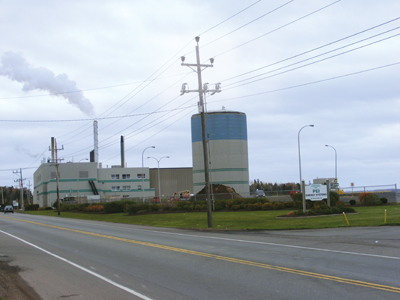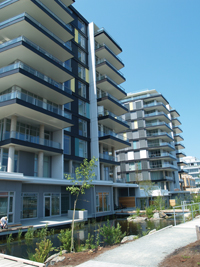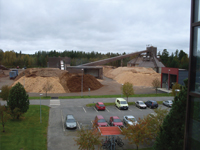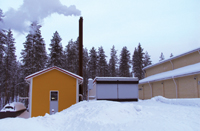
Warming the Neighbourhood
April 22, 2010
By Bruce McCallum
District heating is one of those concepts that give warm and fuzzy feelings to people working in the bioenergy field, but few people have much direct experience with it in Canada.
District heating is one of those concepts that give warm and fuzzy feelings to people working in the bioenergy field, but few people have much direct experience with it in Canada. District heating systems provide heat to multiple buildings from a central biomass heating plant via insulated,
underground, hot water heating and return lines. Entire towns or cities can be heated from a single plant.
 |
| District heating in Prince Edward Island dates back to the first installation in Charlottetown in 1980. |
Biomass-fired district heating is common in Scandinavia, especially in Sweden, where some 270 of 290 urban communities have district heating systems that use biomass as a principal energy source. They are also common in Finland, Denmark, and Austria, where there are aggressive programs to meet Kyoto targets and policy frameworks to support the development of biomass energy.
In Europe, the principal drivers for biomass-fired district heating are rural job creation; support for domestic forest industries; insurance against wildly fluctuating oil and natural gas prices; and the displacement of fossil fuels such as coal, heavy oil, and natural gas with carbon-lean bioenergy that helps them meet Kyoto targets. The insecurities caused by various oil crises, and ongoing disputes between Russia and the Ukraine that have resulted in the cutting off of gas supplies to European countries on several occasions, have also spurred investments in biomass-fired district heating systems across the European Union.
In North America, district heating systems were installed in various U.S. and Canadian cities in the early 20th century. I lived in an area of Winnipeg in the mid-1960s that had previously had a coal-fired, steam district heating system. The district heating line in my home had been disconnected, and a shiny new, compact natural gas boiler had been installed. Natural gas was seen as the fuel of the future in an era that predated growing environmental concerns and in which no one had heard of global warming. Steam district heating systems also have been common at military bases and universities across North America, where there tend to be many large buildings in close proximity.
Prince Edward Island was an early follower of the Swedish bioenergy model. The first district heating plant was constructed in Charlottetown in 1980 to heat a hospital and provincial government buildings. The system was supplied by the Swedish company Ange and Varme, and was fuelled by wood chips from low-grade wood. In ensuing years, the system was expanded to connect other private buildings in the downtown core of the city.
In 1984, a second major district heating network was started at the University of Prince Edward Island. It involved a 3.5-MW wood chip system with a moving step grate, which was new technology at that time. It also used wood chips.
Over the years, these district heating systems were consolidated into one large network as they changed ownership and customers were added as new buildings were constructed in the core area of the city. A large thermal storage tank was added in 2003 to store surplus heat in the late-night hours to meet the typical morning peak when thermostats are turned up and large volumes of hot water are used. Today, the system has some 17 km of high-quality, European, insulated steel piping that provides heat to more than 120 Charlottetown buildings. The current capacity of the plant is maxed out. This is the largest district heating system in Canada.
The Charlottetown district heating system has been a substantial success. It currently displaces over 16 million litres of heating oil annually and about 15,000 tonnes of carbon dioxide. It reduces the number of emissions source points and replaces them with a single larger source that achieves higher energy efficiency with lower total emissions. The company employs 33 people on a regular basis, plus perhaps 6 people who work steadily in wood chip production. The customers save some money relative to oil heating and are assured of relative stability in energy costs. They also avoid capital and maintenance costs for individual building heating systems and oil tanks. Some customers, such as the Charlottetown Hotel, left their oil boilers in place for a while, but eventually removed them and allocated the building space to other needs when it became evident that they were not likely to be used again.
District heating in other regions
There has been interest in biomass-fired district heating in other parts of Canada, and a few systems have been constructed. The most successful model is the Cree community of Oujé-Bougoumou in north-central Quebec. The Band received a large land claim settlement and elected to build a new town. They installed a community-wide district heating system in 1992. The system has since been expanded incrementally, adding a second biomass boiler. It burns sawdust from the Barrette Chapais sawmill, which had a waste disposal problem.
 |
| The first tenants moved into the Dockside Green community in 2008.
Photo: Dockside Green
|
This is unquestionably Canada’s best example of a community-based district heating system. The system heats virtually all of the private homes and public buildings in the town. It has saved millions of energy dollars, and the people of Oujé-Bougoumou are very proud of it. A good deal of success can be attributed to the diligent staff that operate the system and to the assistance provided by engineering consultant Duncan Varey of Toronto, who provided technical support over many years. Varey drafted operating manuals with detailed maintenance schedules and
recommended that the plant stock a good assortment of spare parts so that it is never down for very long when pumps or gear-motors fail. This system serves as a model for remote communities. Not all remote communities have access to sawdust, but could produce wood chips, generating additional jobs.
Two communities in British Columbia built biomass-fired district heating systems in the 2000s. After eight years of planning, the town of Revelstoke constructed a small district heating system that was commissioned in 2005. The 1.5-MW KMW biomass boiler burns sawmill residues from local Downie Street Sawmills and provides steam for the sawmill’s operations, as well as hot water for a school, a community centre, an aquatic centre, hotels, and other buildings. The system has a 1.75-MW backup propane boiler and has reduced the community’s reliance on propane and other fossil fuels.
More recent is the Dockside Green harbourfront community under development in Victoria, British Columbia. This innovative community will involve district heating using a 2-MW Nexterra gasifier, fed with locally sourced wood waste. It will provide the 15-acre (6-ha) community with hot water and heat. The system will have backup and peaking supply from natural gas boilers. A similar community with wood biomass district heating is being planned for Quebec, called La Cité Verte.
District heating has also been considered an option for the far north, where costs to bring in fossil fuels can be exorbitant. In 2008, the city of Yellowknife installed a pellet-fed district heating system for its arena, curling rink, and community pool. These facilities previously used almost 300,000 litres/year of fuel oil. Hay River, Northwest Territories, is installing biomass district heating that will warm four schools. Fink Machines and contractor J&R Mechanical will install the planned 950-kW KOB system in the summer of 2010. This should eliminate the need for about 318,000 litres/year of heating oil.
Added challenges
The Revelstoke district heating project illustrates a key problem faced by developers of biomass-fired district heating systems. Early plans for a combined heat and power plant were scaled down to small-scale heat to avoid costs associated with the requirement for 24-hour on-site monitoring by a boiler engineer. District heating involves accumulating heat loads to achieve economies of scale in the biomass plant. However, provincial boiler staffing regulations typically have very low thresholds for this monitoring requirement. For example, in PEI, the threshold is a combined boiler capacity of 1.5 MW, roughly the size of a modest high school; in the Northwest Territories, it is 950 kW. The added staffing costs outweigh the economic equation necessary to justify building such a system.
Requirements for continuous staffing are a serious problem and are under review in a number of provinces, including Ontario and British Columbia. It is a big challenge to lobby for changes because of the variety of provincial legislation. The receptivity to constructive changes has been rather poor, but recently, some provinces have begun to show interest in addressing these barriers.
What is the future of biomass-fired district heating in Canada? Despite the great success of district heating in Europe and for several successful pilot projects in Canada, the jury is still out in this country. Many rural community development groups see bioenergy and district heating as a bright spot in a sea of rural economic gloom. However, key barriers still need to be addressed. We need to start thinking with a longer-term perspective. District heating systems do make sense if planners are willing to accept a return on investment of 20 years or more, as with other public infrastructure.
The price of fossil fuels is very important, as is the price of carbon. Government policies at all levels must be aligned to promote district heating. We are going to face serious challenges to heat our towns and villages in the coming decades. District heating using renewable, economical biomass offers a practical solution. The systems are very capital intensive, but relatively cheap to operate. Government funding is needed to assist in building what could be hundreds of community-based district heating systems across Canada. Think about what that could mean in your community.
A Scandinavian Example
District heating has a long tradition in Finland, with the first plants already functioning in the 1950s. Today, district heating has a very strong position on the Finnish energy market, accounting for approximately 50% of total space heating. The success of district heating lies in the fact that it is a very reliable and environmentally friendly heating method, particularly for densely populated areas.
  |
| Large-scale (top) and small-scale (above) district heating plants are widespread in Finland and account for a large proportion of the country’s heat energy. Photo: Dominik RöserPhoto: Jouko Parviainen, WENET |
Most of the larger cities in Finland are equipped with a district heating plant. Of the 5.3 million people living in Finland, approximately 2.6 million live in houses that are heated by district heating plants. This means that most public buildings and apartment blocks are heated by district heating networks.
The traditional sources of fuel for district heating plants have been natural gas, coal, peat, and oil, but an increasing number of district heating plants are being converted to wood biomass from local forests. Most of the large-scale operations are combined heat and power plants producing both heat and electricity and reaching very high boiler efficiencies. However, the growth potential of large-scale district heating in Finland is limited because it has already been established in all parts of the country where it is economically feasible.
In contrast, Finland has seen considerable growth of small-scale district heating plants in rural communities over the last ten years. These plants usually range from 500 kW to 10 MW and heat municipal buildings, schools, libraries, and other public buildings using mostly wood from forests within a 30-km radius. In North Karelia, a region in eastern Finland, almost every town has its own small-scale district heating network, and today, approximately 70% of the total energy is produced by these heating plants.
–Dominik Röser, METLA (Finnish Forest Research Institute)
| PEI’s Evolving District Heating System The Prince Edward Island district heating system has changed a lot over the years since its inception. Initial funding for the PEI district heating systems came largely from the federal government through a federal-provincial agreement. The province implemented these projects through its Crown agent, the PEI Energy Corporation, which installed and operated the district heating plants and the heat distribution systems. Initially, a single contractor supplied fuel chips for the district heating systems and about 16 smaller wood chip boilers installed in schools and hospitals across PEI. Things went along at a great clip, fuelled by federal agreement dollars, until oil prices softened and we entered the dark ages – a period of low oil prices and rampant government cutbacks in the mid-1990s. The PEI Energy Corporation was subjected to government-wide cutbacks, which left it unable to expand the district heating systems and with difficulty in performing recommended system maintenance. Most of the smaller chip plants were abandoned by the school boards and hospitals, which were happy to burn cheap oil and avoid the maintenance work of the chip systems. One notable exception was the Prince County Hospital in Montague; it installed a chip burning system in 1981 that is still working today and has saved the hospital millions of dollars. The upshot of that funding dilemma was that the district heating assets of the PEI Energy Corporation were put up for sale and sold to Trigen, a private company, in 1996. Those assets included a garbage burning plant that was heating the Queen Elizabeth Hospital, the district heating system centred at the university, and the original system based at the Prince Edward Home (the former hospital). Trigen refurbished the garbage-burning plant, adding scrubbers, installing a new 11-MW KMW biomass boiler, and relocating a smaller boiler of similar design for a combined capacity of 15 MW. The new system also has a steam turbine and generator that produces up to 1.2 MW of power, which is mainly used within the plant. A larger turbine was considered, but the local utility would not offer a high enough price for power sold to the grid to justify the investment. The company also installed a lot of additional piping, which added more clients and consolidated the three systems into one large network. The Charlottetown district heating system has changed hands several times and now goes under the name of PEI Energy Systems. It is owned by Fort Chicago, based in Calgary, Alberta, which purchased the system for some $50 million in 2008. Fuel supply The energy supply is currently about 45% wood chips; 35% municipal waste, which is declining because of increased recycling; and 17% heavy oil, which is up from 10% a few years ago. Oil use has risen because the capacity of the biomass and waste systems is maxed out. Fort Chicago is considering installing additional biomass thermal and power generation capacity. “District heating systems can be good business under the right conditions,” says David Godkin, Fort Chicago plant manager. “You need access to relatively low-cost biomass or municipal waste, and you need to have a substantial number of good-sized buildings concentrated in a core area of a city.” |
Print this page